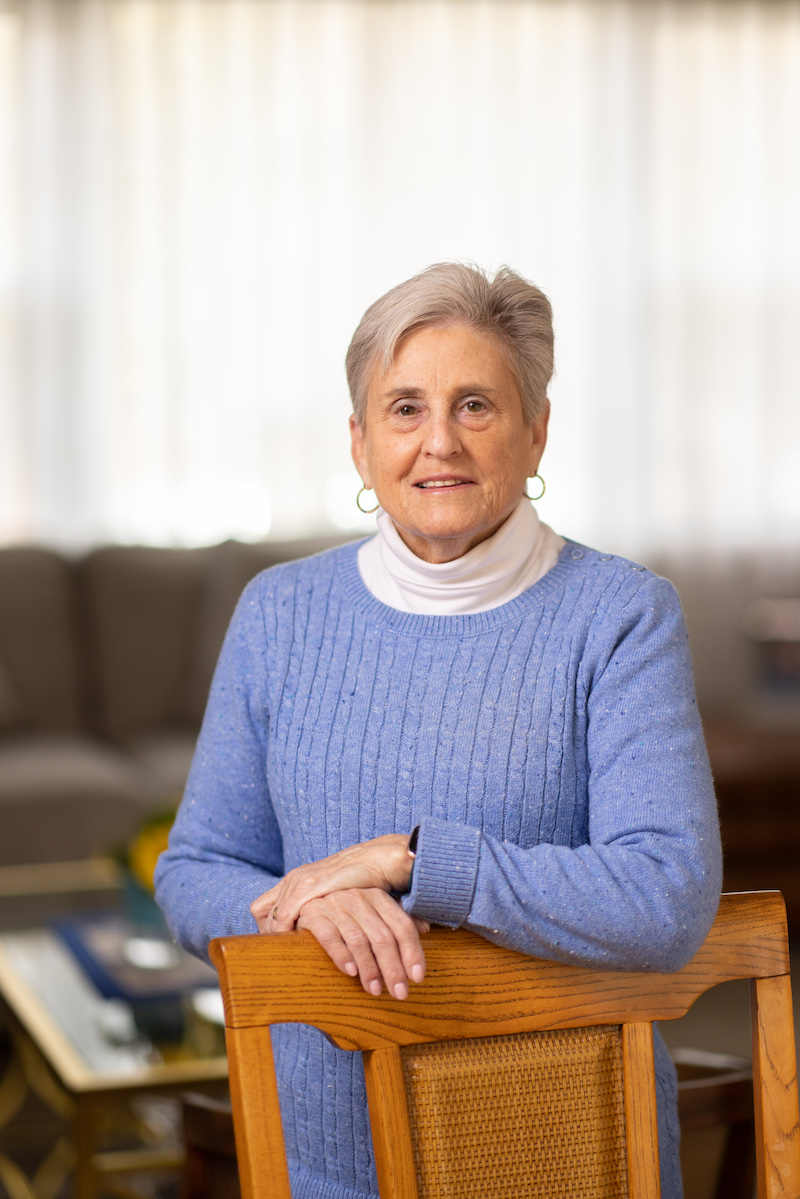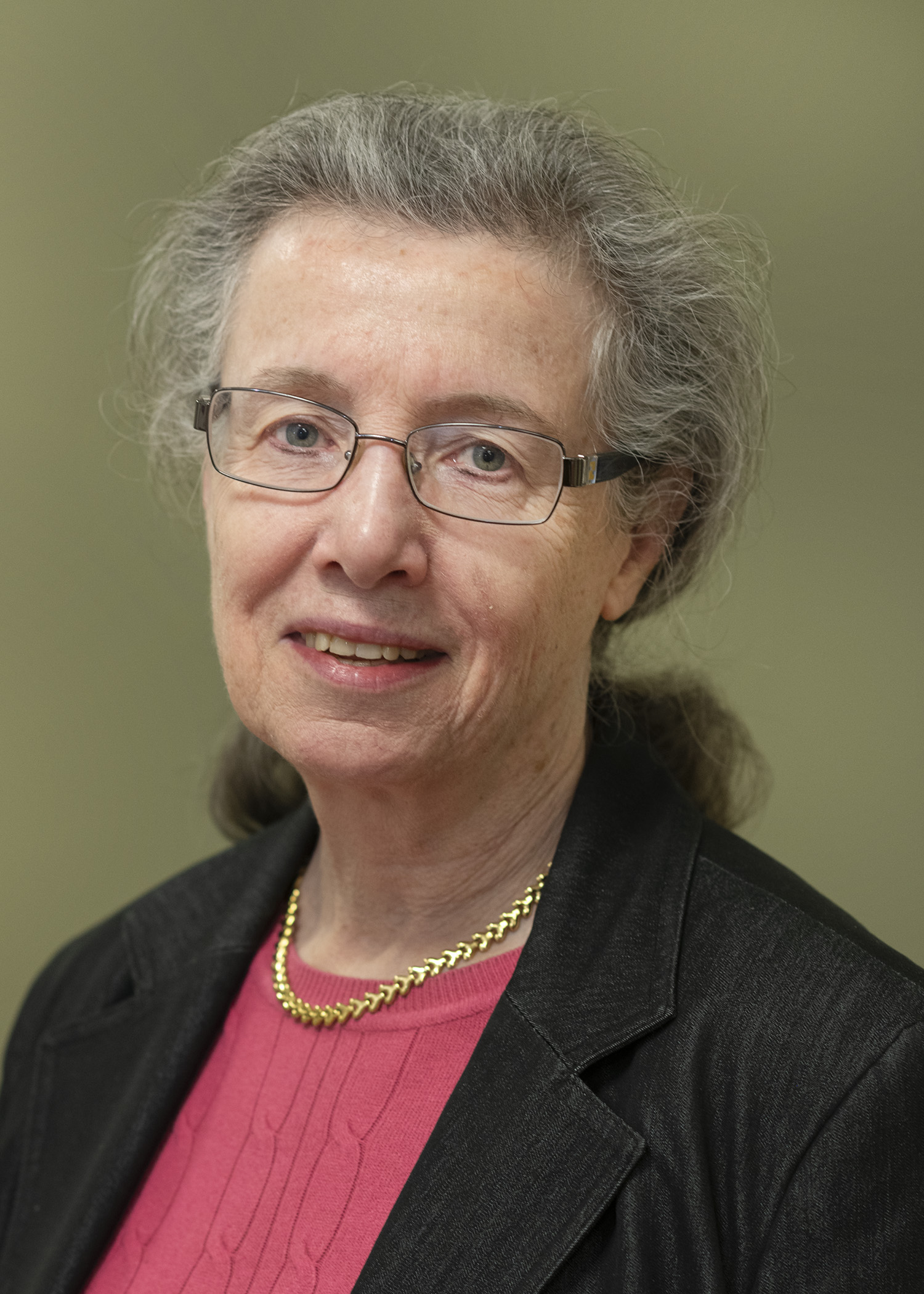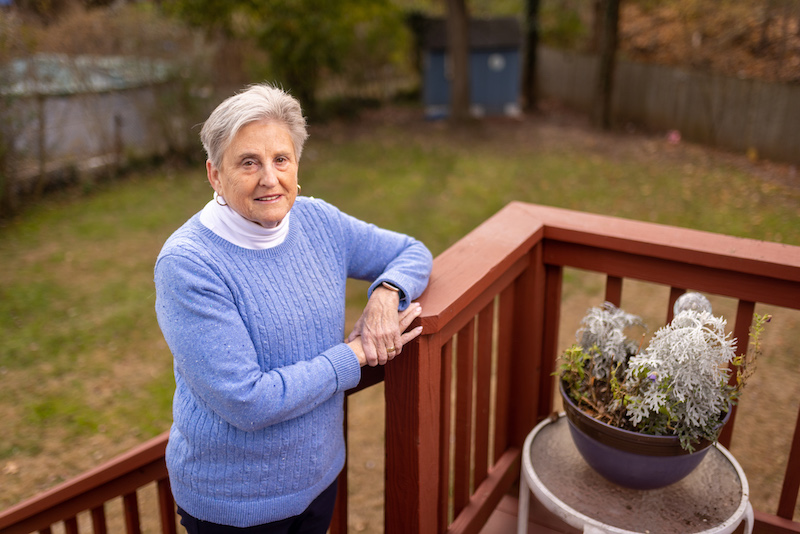Story by Mary Ann Littell • Portraits by John O'Boyle View the complete magazine | Subscribe to Cancer Connection
See the full video component of Adrienne's story
View more patient stories at cinj.org/patientstories
At 71, Adrienne Graubard has a fitness regimen that would exhaust many people half her age. Winter or summer, she walks a minimum of 10,000 steps a day. She’s plugged into 20-20-20, a workout on YouTube that’s guaranteed to break a sweat. She’s a tennis player and a golfer. In short, she does everything she wants to do, and doesn’t let cancer stop her.
“I’ve got to stay active,” she says. “I’m afraid that if I don’t, then I won’t be able to be active. When I can do my normal activities, I’m very happy—because for a long time, I couldn’t do them.”
Seventeen years ago, Graubard, a retired teacher, was diagnosed with plasmacytoma, a tumor of abnormal plasma cells that grows within soft tissue or bone. It was successfully treated and she went back to raising her family and living her life. In 2017, she was blindsided by a second bout of illness: multiple myeloma. This deadly cancer forms in the body’s plasma cells located in the bone marrow. After state-of-the-art treatment by specialists at Rutgers Cancer Institute of New Jersey and RWJBarnabas Health, including a stem cell transplant, she is in remission and feels great.
“It’s been quite a journey,” she says. “I’m very grateful to my doctors—and so fortunate to have a world-class cancer center right near my home. I didn’t have to travel anywhere.”
 Adrienne Graubard
Adrienne Graubard
Graubard, a native of North Plainfield, is happily married to Roger, the love of her life, also a retired teacher. The couple lives near their grown daughter (yet another teacher) and her family. “We come from a long line of teachers,” says Graubard. “But our son broke the mold—he went to New York to do something different.”
Her health problems began in August 2004, when she began having back pain. “I’ve always been active. Back then I was a gym rat,” she recalls. At first, she thought she had pulled a muscle. After months of visits with her orthopedist, some bloodwork and an MRI, “the doctor called me, right in my classroom. He said I had an aggressive cancer called a plasmacytoma and needed immediate surgery.”
With Thanksgiving a week away, she did not want to ruin her family’s holiday. She insisted on a second opinion, so her orthopedist arranged for her to see a neurologist that same day. To her astonishment, he offered her a wheelchair. “He couldn’t believe I was walking,” she notes. “He told me to forget about Thanksgiving. If I didn’t have the surgery right away, I wouldn’t be able to walk.”
The tumor was removed that week and a titanium rod was placed in her spine. “Problem solved – or so I thought,” says Graubard. Her oncologist followed her closely for several years. “In 2014 he said, ‘You’re doing fine. No need to come back anymore.’ I said, ‘Wonderful!’”
In the fall of 2017, Graubard again began having pain, this time in the thigh, groin and hip. Over the next several months she had a myriad of tests, but nothing definitive was found. “Then they did a PET scan. It lit up like a Christmas tree,” says Graubard. A biopsy identified lesions of multiple myeloma in the thigh, hip, and pelvis.
“That floored me,” she says. “None of my doctors had ever told me that plasmacytoma can return as multiple myeloma. So it was a huge surprise…and not a pleasant one.”
Her oncologist explained that the situation was serious and she would need radiation therapy, chemotherapy, and ultimately, a stem cell transplant. “My husband and I said, ‘Whoa!’” she recounts. “How could I need such radical treatment, when I felt pretty good, other than some pain? I trusted my oncologist, but I wanted a second opinion. He gave me the names of several cancer specialists.”
She began radiation therapy at a community hospital while researching the physicians her oncologist had recommended, starting with Kathleen Toomey, MD, a specialist in hematology and oncology at Robert Wood Johnson University Hospital Somerset. “A good friend of mine was a longtime patient of Dr. Toomey’s,” says Graubard. “I knew she was an excellent doctor. I picked up the phone and called her; asked if she could help me. She said yes, absolutely.”

At the recommendation of her onocologist, Adrienne Graubard sought the help of Kathleen Toomey, MD, a specialist in hematology and oncology at Robert Wood Johnson University Hospital Somerset, and medical director of Steeplechase Cancer Center (above), a partner of Rutgers Cancer Institute. “I can’t say enough about this fantastic facility and the staff. They are very professional and take wonderful care of you,” Graubard says.
Dr. Toomey has been medical director of Steeplechase Cancer Center, located on the Somerset campus, since it opened in 2007. She is understandably proud of the services Steeplechase provides. “As a partner of Rutgers Cancer Institute, we take a multidisciplinary approach to care,” she says. “We are able to offer the most advanced approaches to cancer treatment, as well as state-of-the-art clinical trials. We are dedicated to getting as many patients as possible, anyone who might benefit, into a clinical trial. We want to cure cancer!”
Connected to the hospital by a bridge, the center is warm and inviting. Toomey was involved with its design. “I envisioned it looking like a lodge at a national park,” she says. And that it does. Cozy sofas flank the lobby’s flagstone fireplace. “Just after we opened our doors, I came in to see a father and daughter sitting on a couch by the fire,” says Toomey with satisfaction. “That’s just what I wanted.”
Finishing her radiation, Graubard met with Toomey in June of 2018. “Sometimes you treat plasmacytoma and it never recurs. Sometimes it come back as multiple myeloma,” says Toomey. “We think of plasmacytoma as a subset of multiple myeloma. Plasmacytoma is really a tumor of plasma cells that can be anyplace in the body—the skin, brain, chest, bone. Myeloma usually affects the bone.”
She continues: “When I see someone with multiple myeloma, I first ask: Is this patient a candidate for a stem cell transplant? Are they strong enough to go through the procedure? No organ failure? No dementia? Adrienne checked all the boxes, making her a good candidate.”
Stem cell transplant replaces damaged blood-making cells with the patient’s own healthy cells. Over time, the transplanted cells develop into new, mature blood cells. Transplants are performed for patients with a variety of illnesses, including acute and chronic leukemias, myelodysplasia, various types of lymphoma, Hodgkin disease, multiple myeloma, amyloidosis and related diseases.
To prepare Graubard for the transplant, the first phase of treatment would be a combination therapy of carfilzomib, lenalidomide, and dexamethasone (known as KRd), which is given to induce remission prior to the stem cell procedure.
Graubard had four cycles of this treatment at Steeplechase. “I can’t say enough about this fantastic facility and the staff,” she says. “They are very professional and take wonderful care of you. There is even a boutique where you can get wigs, specially fitted bathing suits for breast cancer patients, just everything you could possibly need.”

Kathleen Toomey, MD
Once this treatment was completed, Graubard was referred to Rutgers Cancer Institute’s Blood and Marrow Transplant and Cellular Therapies Program, a collaboration with Robert Wood Johnson University Hospital (RWJUH) in New Brunswick. “The collaboration between Steeplechase and Rutgers Cancer Institute is great for patients,” notes Toomey. “The skilled team of hematologist/oncologists, advanced practice nurses, bone marrow transplant coordinators, nurse navigators, and social workers all work together to make sure patients have the highest quality, individualized care, located only ten miles away. After the transplant, follow-up care is coordinated across the health system.”
In mid-November, Graubard’s stem cells were collected at Rutgers Cancer Institute in a process that is similar to dialysis. She then received higher-dose chemotherapy to destroy any remaining cancer cells. “This was tough,” admits Graubard. “I had nausea and other side effects, and lost my hair immediately.”
A few days later, the stem cells were infused back into her body, similar to a blood transfusion. Graubard went home for a day, then returned to the hospital for a week of monitoring and treatment. “I’d heard horror stories about this phase of the treatment. In retrospect, it wasn’t fun, but it was tolerable,” she says.
She went home to recuperate. “I wasn’t used to feeling this weak,” she notes. “A dishrag probably had more energy than I had. I had to climb one step to get in my house, and I almost couldn’t make it.” Over time, her strength returned. By January she was able to host a party for twelve of her closest friends. “They provided meals for my husband and me for more than two months during treatment, and I wanted to thank them.”
She now feels like her old self. “I’m almost afraid to say it, but I feel really good,” she says. “I’m back to tennis every other week, and I can play catch with my grandsons without getting winded. I see Dr. Toomey every month and get regular PET scans.” She is on maintenance therapy – an oral drug – to keep the cancer in remission.

The skilled team of hematologist/oncologists, advanced practice nurses, bone marrow transplant coordinators, nurse navigators, and social workers that work together to provide the highest quality, individualized care close to home makes the collaboration between Steeplechase and Rutgers Cancer Institute great for patients like Adrienne Graubard (above).
“When I started taking care of multiple myeloma patients three decades ago, they survived for just a few years, and that was mostly in the hospital,” notes Toomey. “We didn’t have much to offer them. But now we have many new treatments and patients are living much longer. If someone has a recurrence, we have multiple options, including clinical trials.”
She sums it up: “With two decades of treatment for serious disease, Adrienne is doing very well, living her life to the fullest. Our multidisciplinary approach is that 100 experts are always smarter than one. Working together, we make absolutely sure that patients are getting the best care every day.”

